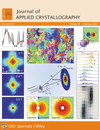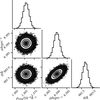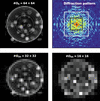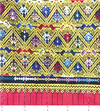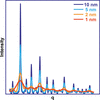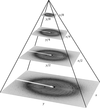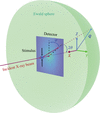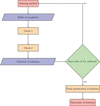issue contents
February 2023 issue

Cover illustration: Rahmani et al. [J. Appl. Cryst. (2023), 56, 200–213] present a machine learning method for distinguishing good and bad images in serial crystallography. To reduce the computational cost, this uses the oriented FAST and rotated BRIEF feature extraction method from computer vision to detect image features, followed by a multilayer perceptron (neural network) to classify the images.
editorial
Free 

A virtual special issue of Journal of Applied Crystallography brings together a series of articles on magnetic small-angle neutron scattering, with the aim of raising awareness of the range of science cases that can be addressed with the technique and exploring future challenges related to magnetic SANS theory and data analysis. It is also hoped that this special issue will encourage collaborations between communities working on long-range-ordered magnetic textures and nanoscale magnetism.
topical reviews
Open  access
access
 access
accessThe status, opportunities, challenges and limitations of machine learning are discussed as applied to X-ray and neutron scattering techniques, with an emphasis on surface scattering.
feature articles
Open  access
access
 access
accessThe members of the Open Reflectometry Standards Organisation outline their best practice for reporting the results of Bayesian analysis of reflectometry measurements. Following this advice will enable greater reproducibility and improve understanding.
research papers
Open  access
access
 access
accessThe performance of the Spatz neutron reflectometer is demonstrated. It has a variable wavelength resolution to suit experimental needs for reflectometry at air–solid and solid–liquid interfaces.
Open  access
access
 access
accessNear-surface SANS is discussed for its potential as a probe of long-wavelength magnetic modulations in specimens with reduced sample dimensions.
Spin-wave scattering in amorphous ferromagnets has been measured by the method of small-angle scattering of polarized neutrons. The method is shown to allow the determination of the spin-wave stiffness of such systems and an inherent energy gap that demonstrates nonconstant behaviour with increasing applied magnetic field.
The rigorous proof that a structure crystallizing in any of the 65 Sohncke types of space groups is necessarily chiral is presented.
A general formalism for X-ray stress analysis with a 2D detector is proposed. As an alternative to radial–azimuthal binning (caking), a direct fitting of the diffraction ring or of a portion of a diffraction ring can be used.
The formalism developed in Part 1 [François (2023). J. Appl. Cryst. 56, 48–60] is used to write general equations for goniometer misalignments with analytical expressions that are easy to handle. It is shown how the values of the misalignment defects can be obtained from measurements on a stress-free (e.g. powder) specimen.
A methodological framework for iterative projection algorithms called the half-cycle multigrid alleviates the twin-image problem in phase retrieval for coherent diffraction imaging using the multigrid method.
Open  access
access
 access
accessThis research examines a type of traditional handwoven skirt from northern Thailand, with the aim of distinguishing the fabrics made by the faster integrated method from those made by the traditional method. Visual and symmetry analysis have been employed to inspect the fabric patterns, the design structure and the symmetries.
Structural parameters of NiSi2 nanoplates and Ni nanospheres grown in different layers of a multilayered sample were determined with improved accuracy from an analysis of grazing-incidence small-angle X-ray scattering (GISAXS) patterns recorded independently after successive chemical removals of outer layers.
Open  access
access
 access
accessComputing scattering intensity using the Debye scattering equation after binning interatomic distances avoids finite size artefacts and is efficient enough for simultaneous refinement of scattering data and extended X-ray absorption spectra by reverse Monte Carlo simulations.
A system has been developed for in situ observation of light-induced structural changes in materials via small-angle neutron scattering (SANS). A simultaneous SANS and UV absorption measurement was employed. The result showed that the newly developed system is very useful for analyzing the structure–function relationship of light-responsive materials.
Open  access
access
 access
accessIt is now possible to integrate the transferable aspherical atom model (TAAM) with NoSpherA2 and refine X-ray diffraction data of disordered, twinned, co-crystal, covalent organic framework and metal–salt structures in a short period of time. A new hybrid approach, allowing a combination of the independent atom model, Hirshfeld atom refinement and TAAM in one structure refinement, is introduced which benefits from the advantages of each method.
Open  access
access
 access
accessThis work compares various formulations which describe diffraction from ultra-thin single-crystal films and shows that, for this thickness range, several implicit assumptions in these formulations are no longer satisfied. This has important consequences for the analysis of diffraction patterns from nanocrystals.
Synchrotron X-ray Laue microdiffraction is used to measure the residual stress in rolled titanium, a metal with known deformation history, and determine the orientation of the residual stress ellipsoid. Previously the method has only been used on naturally deformed quartzites with ambiguous deformation histories.
A quantitative model is introduced to describe the transmission signal of textured polycrystalline materials. The aim is to develop it for use in full-pattern least-squares refinements of wavelength-resolved transmission experiments.
Open  access
access
 access
accessThe article presents the rocking curve imaging instrument at Stanford Synchrotron Radiation Lightsource beamline 10-2, which is used to characterize diamond and silicon crystals for Bragg optics applications.
Open  access
access
 access
accessAn analytical correction equation is proposed to fix the shift in 2θ values caused by specimen capillary displacements for powder diffraction experiments in Debye–Scherrer (transmission) geometry with a flat area detector. The accuracy of this equation and the corresponding corrections were verified by comparing it with a correction based on new integration parameters from an internal reference material.
An analytical and general form factor for any polyhedron is derived on the basis of a projection method. The obvious singularities from the formula are discussed in detail.
A new method for pole figure measurement is described, entitled a dynamic segmented spiral scheme. This scheme provides a promising alternative to conventional methods of simultaneous texture and phase fraction measurement.
This article describes accurate unit-cell parameter determination of an unknown crystal structure using Niggli cell reduction theory and quantitative model-based analysis of high-resolution (scanning) transmission electron microscopy images.
Open  access
access
 access
accessA machine learning method for distinguishing good and bad images in serial crystallography is presented. To reduce the computational cost, this uses the oriented FAST and rotated BRIEF feature extraction method from computer vision to detect image features, followed by a multilayer perceptron (neural network) to classify the images.
Open  access
access
 access
accessThe use of the bicone model is validated for extracting the form factor of gold bipyramids in solution from small-angle X-ray scattering data.
The structural and microstructural responses of a model metal–organic framework material, Ni(3-methyl-4,4′-bipyridine)[Ni(CN)4] (Ni-BpyMe or PICNIC-21), to carbon dioxide sorption are measured, in situ, using small-angle X-ray scattering and X-ray diffraction under both dual gas flow and supercritical CO2 pressure conditions. Experimental results are compared with density functional theory predictions aimed at providing insights concerning how such materials can be designed or modified to optimize the desired gas sorption properties.
Open  access
access
 access
accessSmall-angle X-ray scattering intensity is simulated for multiscale Boolean models of spheroids.
X-ray diffraction has revealed the deformation behavior in ferroelectric triglycine sulfate single crystals. The deformation is a superposition of compression, the piezoelectric effect and domain evolution. Analysis of X-ray diffraction patterns allows estimation of the strain uniformity.
The accuracy of strain energy evaluation of dislocated crystals has been analysed using X-ray diffraction methods. The modified Williamson–Hall plot leads to better agreement with the known value of the strain energy than asymptotic line profile analysis, which overestimates it by 50%.
A new procedure for separating a multi-component powder diffraction pattern into individual component patterns has been developed. It can separate the patterns without utilizing the pattern model for one of the components. It can be used for the powder data analysis of materials containing a component material of low crystallinity, of an unknown material coexisting with known materials etc.
A general spherical harmonics method has been developed to transform X-ray total-scattering data into anisotropic pair distribution functions. It provides an ideal tool to investigate local structural changes under the application of external stimuli.
computer programs
Open  access
access
 access
accessAn open source Python package named xrd_simulator, developed to address the need for 3D microstructure morphology simulation in 3DXRD-type experiments, is described and demonstrated.
This article describes the crystallography package ParaCell for indexing from powder diffraction data.
Algorithms and software have been developed to decompose spherically symmetric oscillating functions in space into a sum of specially designed shell functions. Such decomposition allows the analytical expression of a resolution-limited atomic image as a function of the atomic coordinates, isotropic disorder parameter and local resolution associated with the atom.
Open  access
access
 access
accessComputer software for the analysis and extraction of high-energy surface X-ray diffraction data is presented.
letters to the editor
In a recently published paper, Nespolo & Benahsene [J. Appl. Cryst. (2021), 54, 1594–1599] state that `chiral crystal structures from achiral molecules can occur in 28 types of space group having screw axes np, with p ≠ n/2, not in any Sohncke type of space group'. It is argued that chiral crystal structures from achiral molecules, in fact, occur in all 65 Sohncke space groups.
The authors respond to Rekis's [J. Appl. Cryst. (2023), 56, 322–323] comment on the article by Nespolo & Benahsene [J. Appl. Cryst. (2021), 54, 1594–1599].
book reviews
Free 


 journal menu
journal menu









